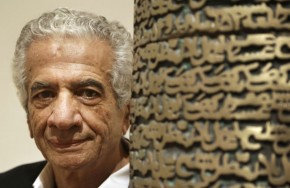Leading Iranian artist banned from travelling to London

The leading Iranian artist Parviz Tanavoli was unable to attend a talk yesterday (3 July) at the British Museum in London after his passport was confiscated by the Iranian authorities. The lecture, which focused on the book European Women in Persian Houses, went ahead without Tanavoli, its author, was who was left in the dark about why he was not allowed to travel.
The veteran artist’s sculptures are included in the Tate Modern’s rehang alongside paintings by Warhol and Lichtenstein in a room called Beyond Pop. They were also featured in Tate Modern’s exhibition The World Goes Pop last year.
Tanavoli was told by border officials on 2 July at Tehran’s Imam Khomeini International Airport that he could not leave for London. The artist, who divides his time between Tehran and Vancouver, told us in an email: “I am still pending and I still have no idea why I am kept here. They tell me soon my case will be sorted out. What case? When is soon? I have no idea.” Officials at the Iranian embassy in London declined to comment.
Tanavoli was also due to speak at Asia House in London today (4 July) on the role of the lion in Persian art and culture. The talk pre-empts an exhibition due to open at the Museum of Contemporary Art in Tehran next March entitled The Lion in Iran and the Art of Parviz Tanavoli.
Tanavoli is known for pioneering a new form of Pop art in Iran in the 1960s. “Like Basquiat making art at another time and in another place, he roamed the streets of south Tehran in the 1960s, finding discarded objects,” says Shiva Balaghi, a visiting scholar at Brown University in Rhode Island, who co-organised a retrospective of Tanavoli’s work last year at the Davis Museum, Wellesley College in Massachusetts.
The Saqqakhaneh school, which also included the artist Hossein Zenderoudi, flowered in Tanavoli’s Atelier Kaboud workplace in south Tehran. This new school fused avant-garde theory with Iranian folk culture motifs, producing a Middle Eastern strain of 1960s modernism rooted in popular culture.
Back